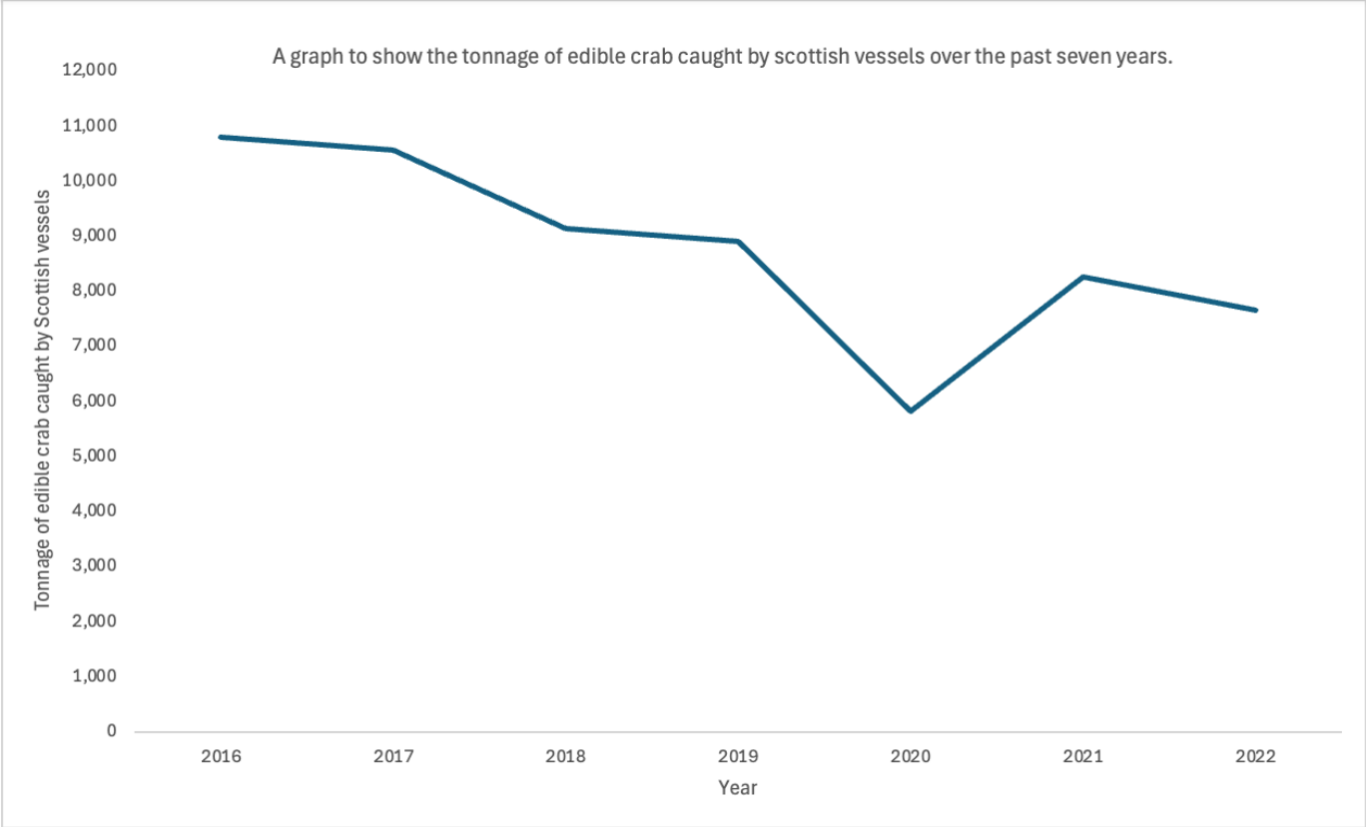www.stateofthecoast.scot
Brown Crab (Cancer pagurus)
Key Findings
Distribution:
Brown crab, also known as 'edible crab', is found in a wide range of regions including the North Sea, Irish Sea and the English Channel. Brown crabs are adaptable, thriving in environments with both rock and sandy substrates where they seek shelter under large boulders or in crevices (North Western IFCA, 2024). They can be found in areas ranging from shallow sub-littoral zones to deeper offshore waters, reaching depths of over 100 metres (Marlin, 2024). Brown crabs primarily feed on live prey such as mussels, whelks and other crustaceans, and will also scavenge off the ocean floor (The Wildlife Trusts, 2024).
Moulting and Breeding Behaviour:
Brown crabs are very productive, with average brood sizes between 0.25 to 3 million eggs per female (North Western IFCA, 2024). Mating occurs through copulation in spring and summer, shortly after the female has moulted (Brown & Bennett, 1980). After mating, females carry eggs under their abdomen in a state known as 'berried' for 6 to 9 months. During this time they do not feed and remain in pits dug into sediment or under rocks, meaning they are rarely caught in creel pots during this time. Larvae are then released in late spring or early summer (Thompson et al, 1995).
Brown Crab Abundance:
Brown crab is considered a data-limited species, meaning there is insufficient knowledge of its population parameters. This challenge arises from the difficulty in determining age, a common problem with species that undergo moulting. Consequently, conventional age-structured population assessments are not effective for crustacean stocks (Mesquita et al, 2017). The waters surrounding Britain and Ireland provide an ideal habitat for brown crab, and between 2015 and 2019 UK waters accounted for approximately 60% of the global brown crab catch. Alongside the UK, other countries such as Ireland, Norway, and France play significant roles in this industry (Hopkins et al, 2024).
Importance to Scotland:
Scottish creel fisheries have a rich history rooted in tradition, focusing on a diverse range of species, including; brown crab, velvet crab and European lobster (Mesquita et al, 2023). The primary areas for brown crab fishing in Scotland include the Hebrides, Orkney, Sule, the East Coast, Papa and South Minch. Together, these regions have contributed to around 80% of the total brown crab catch in Scotland in recent years (Mesquita et al, 2023).
Between 2016 and 2022, Scottish vessels landed over 61,266 tonnes of edible crab generating a significant profit (Scottish Government, 2023). While these figures are impressive, they represent only a fraction of a potential yield, as brown crab landings steadily declined during this period. Notably, in 2020 there was a reduction of over 30% in brown crab caught (fig. 3).
Future of Brown Crab in Scotland:
Brown crab are vital not only as a source of income for various Scottish communities, supporting industries such as restaurants and fishmongers, but also for their important contribution to ecosystem structure. Crab larvae make up a significant portion of plankton communities, serving as an essential food source for numerous other key species. Their overexploitation could lead to the collapse of entire food webs and result in a loss of biodiversity in British waters.
The future of the species remains uncertain as demand continues to drive larger annual catches, with recent reports indicating continuously dwindling numbers in certain areas of Britain. Much like the European lobster, selected interim measures will be implemented in Scotland from 12th May 2024, such as the prohibition on landing of egg-bearing crab and lobster into Scotland. Alongside this, there are controls on creel fishing vessels of more than 12 metres overall with a track record of landing more than 200 tonnes of crab and / or lobster in any 12 month period since 2020 (Scottish Government, 2024).

Fig. 1: Brown Crab: Cancer pagurus

Fig. 2: Distribution of Brown Crab in Europe

Fig 3: A graph to show statistics of edible crab landings from 2016-2022, created by George Trantham using the Scottish Sea Fisheries statistics.
Notes
None
Linked Information Sheets
Key sources of Information
Marlin (2024) Edible crab (Cancer pagurus)
Mesquita et al (2017) Crab and Lobster Fisheries in Scotland: Results of Stock Assessments 2013-2015
Mesquita et al (2023) Crab and Lobster Fisheries in Scotland: Results of Stock Assessments 2016-2019
Scottish Government (2023) Scottish Fisheries Statistics 2022
North Western IFCA (2024) Brown / Edible Crab
Scottish Government (2024) Scottish crab and lobster management improvements from May 2024
Reviewed on/by
31/10/2024 by Mariia Topol
22/01/2025 by Charlotte Tomlinson
25/01/2025 by Mariia Topol
05/03/2025 by Charlotte Tomlinson
Status
Live - Next update 03/03/2026
To report errors, highlight new data, or discuss alternative interpretations, please complete the form below and we will aim to respond to you within 28 days
Contact us
Telephone: 07971149117
E-mail: ian.hay@stateofthecoast.scot
We need your consent to load the translations
We use a third-party service to translate the website content that may collect data about your activity. Please review the details in the privacy policy and accept the service to view the translations.

